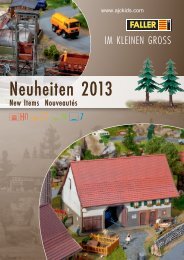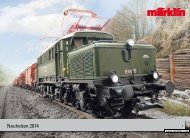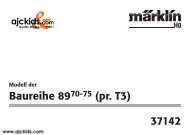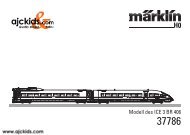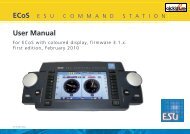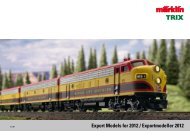ICE 2 (Baureihe 402) - AJCKIDS.com
ICE 2 (Baureihe 402) - AJCKIDS.com
ICE 2 (Baureihe 402) - AJCKIDS.com
Create successful ePaper yourself
Turn your PDF publications into a flip-book with our unique Google optimized e-Paper software.
Information zum Vorbild<br />
Seit Juni 1997 verkehrt die zweite Generation der<br />
Hochgeschwindigkeitszüge der Deutschen Bahn<br />
AG, der <strong>ICE</strong> 2. Die Konzeption dieser Züge der<br />
<strong>Baureihe</strong> <strong>402</strong> unterscheidet sich grundsätzlich von<br />
den bisherigen <strong>ICE</strong> 1-Zügen. So kann ein <strong>ICE</strong> 2<br />
z.B. in Berlin als Langzug starten und in Hannover<br />
in zwei Halbzüge geteilt werden, von denen einer<br />
nach Bremen und einer nach Köln fährt. Diese Flexibilität<br />
ermöglicht es, Linien mit weniger starkem<br />
Fahrgastaufkommen wirtschaftlich zu bedienen.<br />
Durch automatische Kupplungen am Triebkopf<br />
und am Steuerwagen können die Halbzüge sehr<br />
schnell gekuppelt bzw. getrennt werden. Die<br />
Speisewagen zum <strong>ICE</strong> 2 stehen inzwischen auch<br />
zur Verfügung. Ein Halbzug umfasst dann einen<br />
Triebkopf, 6 Mittelwagen und den Steuerwagen.<br />
Die Dauerleistung von 5,0 MW ermöglicht eine<br />
Höchstgeschwindigkeit von 280 km/h.<br />
2<br />
Information about the Prototype<br />
The second generation of the German Railroad,<br />
Inc.’s high speed train, the <strong>ICE</strong> 2, has been in<br />
operation since June of 1997. The design for these<br />
trains, the class <strong>402</strong>, differs fundamentally from<br />
the earlier <strong>ICE</strong> 1 trains. An <strong>ICE</strong> 2 can start in Berlin<br />
as one long train and in Hanover it can split into<br />
two halves, of which one will go on to Brumen and<br />
the other to Cologne. This fl exibility enables economic<br />
service on lines with fewer passengers.<br />
Automatic couplers on the power end unit and<br />
the cab control car allow the half trains to be<br />
coupled and uncoupled very quickly. A dining car<br />
has also be<strong>com</strong>e available on the <strong>ICE</strong> 2. A half<br />
train consists of a power end unit, 6 intermediate<br />
cars and a cab control car. The train’s continuous<br />
power output of 5.0 megawatts (approximately<br />
6,705 horsepower) allows a maximum speed of<br />
280 km/h or 175 mph.



